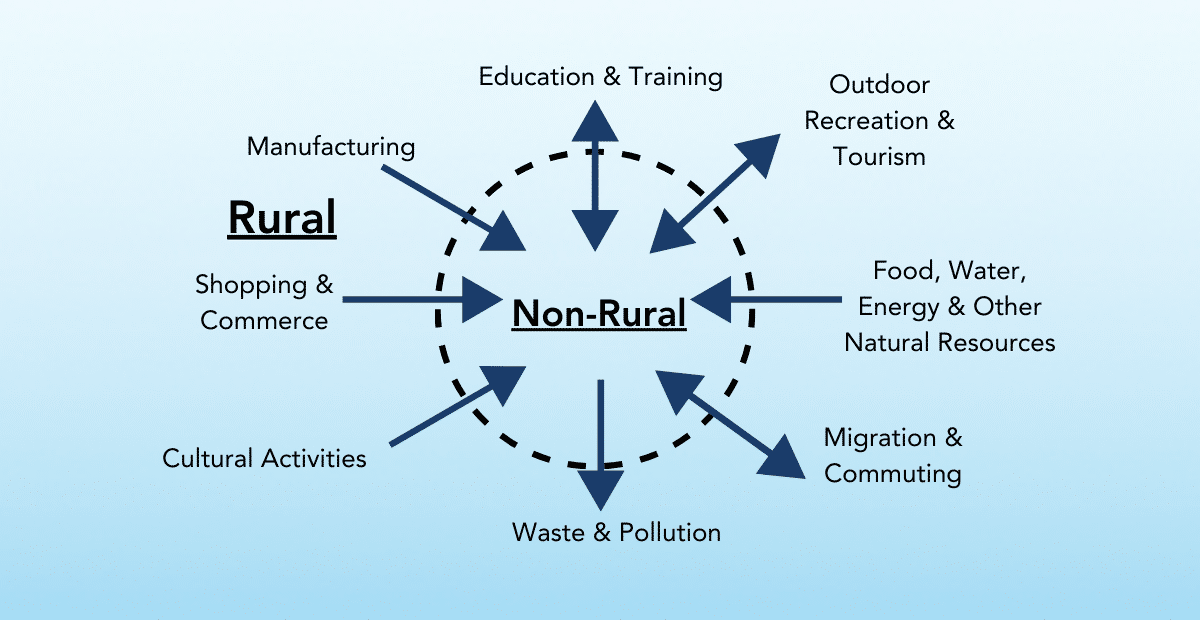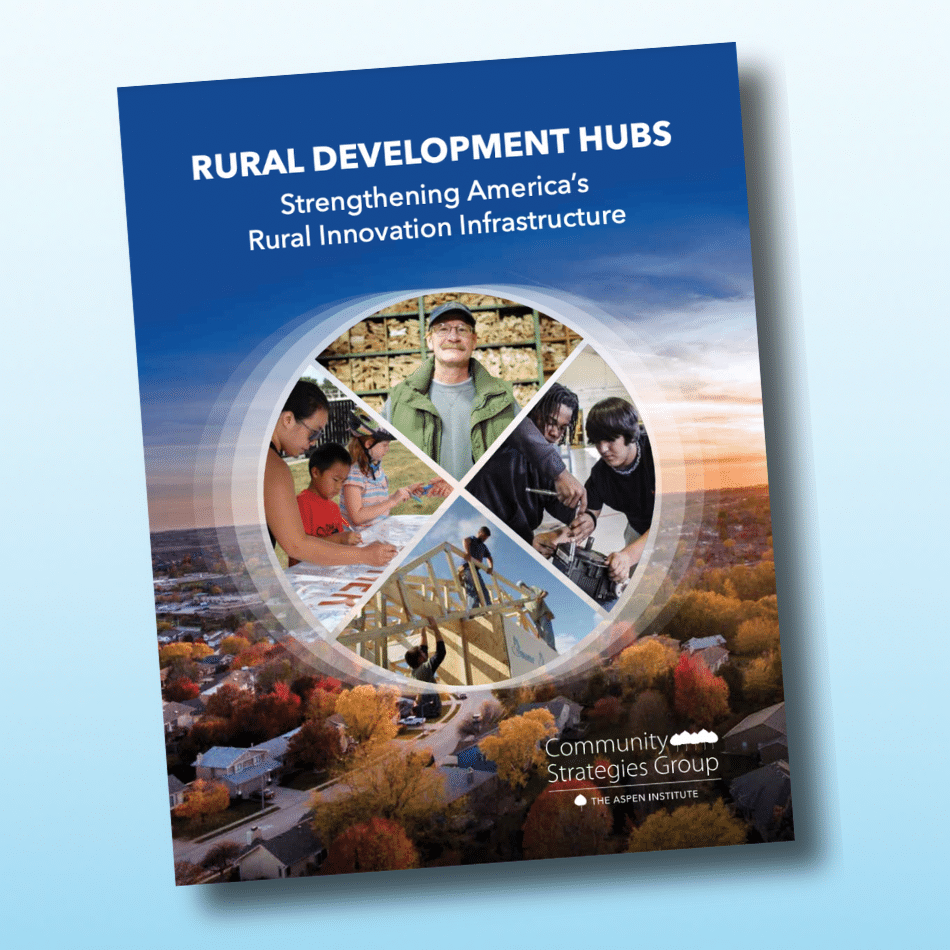New efforts focused on environmental justice, just transitions, corporate stakeholder engagement, scientific conservation efforts, and Indigenous wisdom are helping balance natural ecosystems and strengthen local communities. These efforts attempt to mitigate the inequitable practices and policies based on race, place, and class that often burden the most under-resourced rural and Native nation communities with negative environmental and social consequences.
On June 10, 2022, over 50 rural community practitioners and allies gathered at an Open Field session to share how they think and act on rural environmental justice, including ideas on just and equitable energy transitions. This blog curates the themes, ideas, and resources shared by participants.
This discussion was grounded in Aspen CSG’s Thrive Rural Framework — especially the Foundational Element. Based on research and best practices from the field, this framework shows what needs to be true at the local-level and systems-level for equitable rural prosperity to occur. Read about how the Thrive Rural Framework features stewardship and environmental justice as an important component of equitable rural prosperity in our recent Stewardship + Equity brief.
Centering the Community
Participants shared the key insight that environmental justice must begin by centering the voices and perspectives of the community, particularly those most negatively affected by economic and environmental decisions. Centering the community can take many different forms; however, to be successful, it must occur at both the local and the systems levels. Participants agreed that a community-centered approach is the only basis for environmental justice work and an equitable future for rural communities.
Environmental justice covers a wide range of issue areas. A participant from North Carolina shared how food processing and the wood pellet industry is creating many negative environmental consequences for the surrounding community. From their perspective, there is a perception that environmental justice is about cities and suburbs and that rural places need to be part of the conversation. Another participant voiced how rural areas are home to landfills filled with trash from urban and suburban areas and that these other geographies rarely consider how actions might impact someone from farther away. Additionally, a participant shared how many industries contribute to groundwater pollution, but without data on pollution, a rural community often cannot compete with well-resourced corporations to demand fair and just cleanup of that pollution.
Within rural communities, the most vulnerable populations may need additional support. One participant shared how their community is working to support the unhoused population who camp, forage, and fish in dioxin-polluted lands and waters. The community is creating clear, visible signage posted by streams to warn of the dangers.
Environmental justice requires work at the local and systems levels. Well-intentioned national and regional organizations must center the community in their environmental justice work. One participant shared how the West Virginia New Jobs Coalition is holding deep listening sessions with many communities. He shared that the first step of any effort must be to have deep and sometimes challenging conversations in local, historically coal-producing communities. By meeting residents at community centers and town halls across the state, they aim to grow solutions for a just and equitable transition grounded in community that account for the diverse needs of various communities.
Similarly, participants noted that well-intentioned outsiders, like scholars and academics, too often approach rural communities with already-baked solutions. They suggest that instead of telling a community what approaches will work best, listen and learn about the community and its context. What’s more, academics and officials need to provide comprehensible information geared to educate citizens on local issues that affect them. This could be as simple as explaining academic research and data science in plain language – helping to equip communities with accurate, usable information can help them advocate and make good environmental justice and development decisions.
Public officials can be key players or allies in local environmental justice efforts. One elected official from a town in the Colonias region in Southern Texas shared their work to tackle the challenge of illegal dumping, particularly the dumping of old tires. Their community has worked regionally, collaborating with the water authority district and water improvement district, to protect the watershed from dumping and pollution. Regional stakeholder groups came together to discuss this issue and develop a new strategy. Now they are using dumped tires to rebuild local roads and trails.
State-level efforts can also lead to positive environmental justice outcomes. One participant shared how the organization Front and Center had helped advance Washington State’s HEAL Act. This first-in-the-country legislation requires state agencies to focus spending on under-resourced and overburdened communities to address environmental justice. It has a new mapping tool to help local communities and state agencies advocate and coordinate efforts.
Zoning Challenges
Many participants brought up challenges related to zoning, including a tool that can help understand land use in the United States. One challenge shared was how government boards are rezoning rural residentially-zoned land into industrial. This results in fewer quality housing options or opportunities and potentially more industrial pollutants in the air, ground, and water.
Participants suggested the need to work closely with un-elected zoning boards, particularly during comprehensive plan updates, to help them understand the need to keep land open and explain why zoning changes may reduce the quality of life and environment for the area. They also suggest reaching out to elected officials on zoning and explaining why maintaining the rural quality of life is important for the community.
Local elected officials have the final say in many development decisions, so participants noted that it is critical to communicate community needs with elected and non-elected officials during the planning process. By engaging before the final decision is made, community members can help shape the type of developments that are built. One participant shared that business developers often don’t know what is best for the community, and more opportunities for local businesses are needed, not more “Big Box” stores. He suggested more voices are needed at the local level to communicate environmental justice values to elected officials.
One participant noted that local NIMBY (Not In My Backyard) movements can potentially exacerbate already-existing environmental justice issues through zoning and development decisions. Wealthy, often white, portions of a wider community tend to have more political influence, and one participant noted that this power could be used to push polluting industries into poor and non-white communities or prevent new developments that could reduce food deserts or advance affordable housing. Community action, storytelling, and raising awareness of the consequences of zoning decisions were all offered as potential steps forward.
Just and Equitable Transition
Many participants shared how working on just and equitable transitions from coal can lead to new community and economic development opportunities. One opportunity that participants highlighted is brownfield remediation, the cleaning up of contaminated land such as coal plants or mines to make them useful for the community.
Participants suggested that coal plant and mine remediation can preserve the quality of rural communities because it creates local jobs and prioritizes redevelopment over new development. One participant suggested taking information about the economic and community potential of remediation to local planning and zoning commissioners and city or county councils. These entities are not necessarily aware of the potential opportunities that cleaning and repurposing land can have and that it may open their eyes to see new possibilities. Another shared that the Just Transition Fund can be a resource for communities interested in learning more.
While redeveloping coal fields and plants is a great goal, one participant noted that a potential roadblock is that it can be hard to discover how much remediation will cost because corporate records are often incomplete or unavailable. Not knowing how much remediation will cost can deter investors and developers of a potential site. US EPA programs can help by providing an environmental assessment of these former industrial sites, and they can document the environmental liabilities. This can reduce or eliminate the liability for a new landowner and potentially help the new owners access federal funds for cleanup operations. Another participant suggested the passage of the RENEW Act currently in Congress would help fund the remediation of mines closed since 1977, filling a major funding gap on abandoned mine reclamation.
More than one participant noted the tremendous opportunity to reduce pollution and create jobs through remediation work. A recent report produced by RMI shows that remediation of mines and plants can be a short to medium-term job “off-ramp” from a local coal economy and sets up future uses like outdoor recreation, tourism, and affordable housing.
One of the most significant pollutants to consider is coal ash, a waste product left over after burning coal. One participant shared that the pollution from coal ash disproportionately affects Black and Brown communities. They offered a mapping tool that may help communities identify the risks and opportunities in remediating coal ash and a report that explores the economic and health benefits of coal ash cleanup.
Teaming with Nature
Participants were particularly eager to discuss regenerative environmental solutions and opportunities that connect with and restore natural systems to create resilience. One participant shared a story of how in the South, some farmers use carbon sequestration in soil for multiple benefits: the healthier soil increases agricultural yields and helps retain water which has the dual impact of mitigating drought and reducing flood risks. In reducing flood risk, carbon sequestration projects can protect communities living in floodplains or flood-prone areas – land because of its market value likely to be occupied by more vulnerable and under-resourced communities. One goal voiced by participants was a regenerative verification for agricultural products, much like the USDA Organic label, that would signal the multiple benefits of a product for consumers. Another participant shared tools related to preparing flood-prone communities.
Participants voiced excitement about the multiple benefits of regenerative ecological efforts, like this one described during the session: Communities upstream of Jackson, Mississippi, worked to restore 27 miles of the Pearl River to protect their drinking water supply. Restoring the river has provided cleaner water for nearby communities, increased the natural habitat, and mitigated flooding, all with the benefit of creating economic opportunities for the region through boating, hiking, and fishing recreation.
This is not unlike the effort in the Arkansas Delta, where communities are harnessing new conservation easements on some flood-prone and less economically viable land to restore wetlands. With the restoration of wetland forests, robust opportunities for hunting, fishing, and recreation are creating new economic opportunities for the region. Furthermore, formal carbon offsets that put a value on the carbon sequestered by the land newly under conservation easement are a growing revenue source for farmers and landowners in the persistently poor region.
3 Big Ideas for Funders
Fund collaboration and regional efforts
Philanthropy should deploy its power to convene unlikely stakeholders and amplify regional efforts. One example of this shared during the session is the Sustainable Forestry and African American Land Retention Network (SFLR). This group of primarily Black landowners in the Southeast are working to educate and advocate around the issue of heirs’ property – a legal circumstance that makes it hard for families to unlock the equity in their land and makes them vulnerable to predatory land acquisition. The US Endowment for Forestry and Communities and the Center for Heirs’ Property Preservation are supporting the efforts of the SFLR and spreading awareness of this important environmental justice issue – and the incredible economic opportunity to unlock the value of land for the families who own it.
Fund capacity building and grant-writing
Collaborating regionally allows small communities to combine their resources to support shared grantwriters, reducing the competition among smaller communities and allowing them to draw down more federal money to support environmental justice efforts. One participant from philanthropy in Minnesota shared how their organization is funding regional grantwriters to support collaborative applications for federal resources – and support the often tedious reporting required for federal grants. As noted in a previous blog, supporting grant writing efforts is very important right now, given the historic amount of money available to rural communities – and the challenge rural places often have in drawing down and reporting on those funds.
Fund storytelling and data gathering
Philanthropy and other well-meaning investors should consider funding efforts that translate rural community storytelling into concrete data that can be used in official testimony in local development and zoning decisions. A participant from North Carolina shared how their historically African American community is experiencing intense pressure from both industrial development and gentrification from the nearby city of Durham. Their community-based organization is working to preserve green space, grow community gardens, and advocate for the interests of rural residents with the Durham city council and local developers by showing up to council and zoning board meetings. Their big challenge was a lack of data to back up their position – so they have begun working with a local storytelling organization to help clarify and uplift the voices of rural residents and translate those stories into data useful for a wider discussion of land use and planning.







